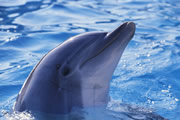|
Scheme to track rare dolphins hits troubled waters
Tracking tags may damage cetaceans.
David Cyranoski
Nature Science Update
11th March 2004
Tracking tags may damage smaller dolphins.
© GettyImages
A plan to help save one of the smallest and rarest species of dolphin has divided conservation biologists.
New Zealand's conservation department wants to track between 10 and 50 Maui's dolphins (Cephalorhynchus hectori maui) by attaching a satellite tracking device to their fins. But critics are concerned that the plan could do more harm than good.
Only about 150 of the 1.7-metre long dolphins remain, and government officials say that the tags could be used to direct fishing boats away from the mammals.
In the past three years, seven Maui's have been washed up on New Zealand's shores, probably as a result of becoming tangled in fishing nets, says Rob McCallum, a senior scientist at the conservation department. "In a population of 150 dolphins, that's a lot," he says.
But the 50-gram transmitter tags, which are fixed to a fin by two nylon pins, could upset and injure the dolphins - or even kill them, say critics. Maui's are much smaller than most of the other mammals on which the technology has been tested, they note.
In a letter to McCallum last November, Nick Gales, a biologist at the World Conservation Union, called for a "thorough risk assessment" before the technique was used on the Maui's. "The level of concern is particularly high for the smaller species, given that the potential impact of the tag is related in part to the size of the animal," he wrote.
And in a report this January, Ian West and Simon Childerhouse, marine-mammal specialists at the conservation department, questioned how useful the tagging data would prove to be. They recommended that non-invasive methods, such as aerial sightings, be used instead.
But on 5th March, the conservation department began a three-month trial to test both the safety and usefulness of the tagging system. Researchers have tagged three Hector's dolphins, which are close relatives of the Maui's and are roughly the same size.
McCallum, who is managing the trial, says that satellite tracking has to be tested, even if it carries some risks. "We are not prepared to just watch as this species slides into extinction," he says.
Top
|
